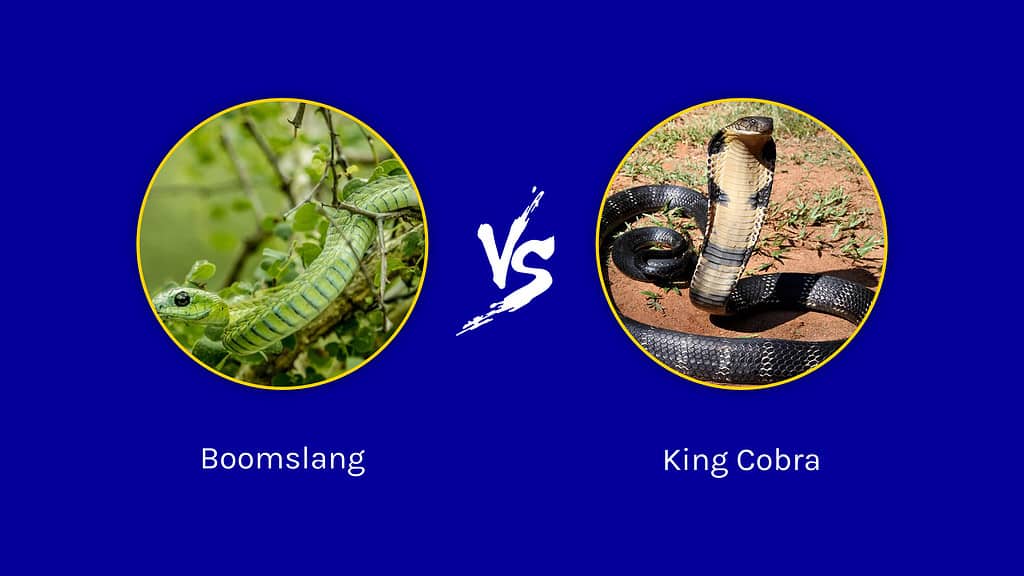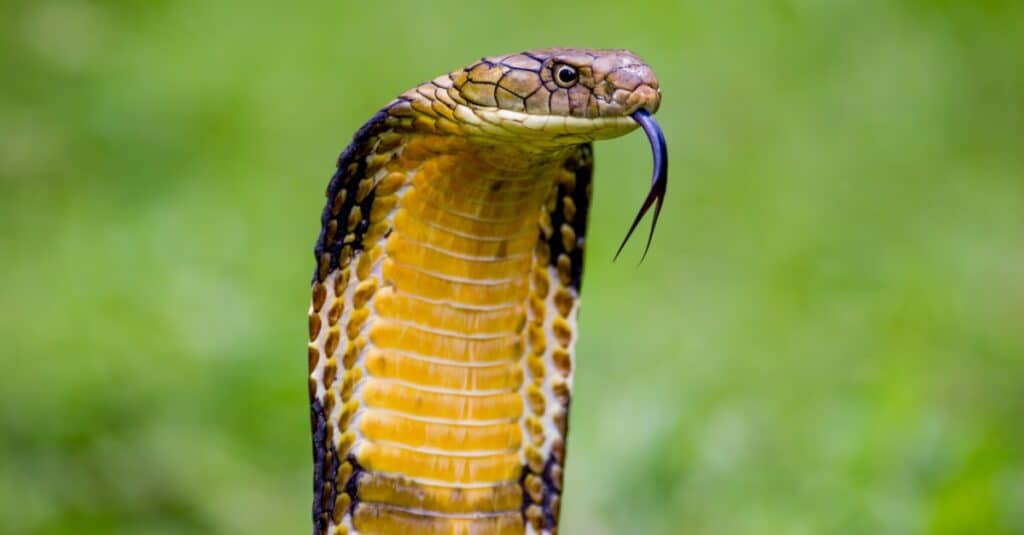Key Points:
- Both boomslangs and king cobras belong to the order Squamata, but the boomslang belongs to a diverse family of venomous and non-venomous snakes called Colubridae. King cobras belong to the all-venomous Elapidae family.
- While king cobras are exclusive to Southeast Asia, boomslangs can be found in the African countries of Mozambique, Zimbabwe, Swaziland, Namibia, Chad, Nigeria, Guinea.
- King Cobras are considered an endangered species. Boomslangs, on the other hand, are designated as a species of least concern. Their exact population is unknown.
The king cobra is not new to fame. It’s a character from many of our favorite stories and fairy tales. Its graceful moves are features of some of our favorite kung-fu styles too. It’s a pet of some and, sadly, a subject of many street performances in Southeast Asia- a threat to its existence. On the other hand, you’ve probably never heard of a boomslang before if you don’t fancy Marvel comics (A Marvel comics supervillain is named Boomslang).
Considering how timid they are, they don’t mind either. However, the differences between both snakes go way beyond a popularity contest. Kindly read on to learn more!
Comparing a Boomslang and a King Cobra

| Boomslang | King Cobra | |
|---|---|---|
| Size | The average length is 4-6.5 ft. | Can grow up to 18 feet long. |
| Phylogenic Families | A diverse family of venomous and non-venomous snakes- Colubridae. | Belongs to the Elapidae family. |
| Distribution | Africa- Mozambique, Zimbabwe, Swaziland, Namibia, Chad, Nigeria, Guinea. | South-East Asia. |
| Morphology | Large eye-to-head ratio, with fangs located at the back of the upper jaw. They have thin and slender green bodies, which aid camouflage. | Long, slender body with multi-colored scales. Characteristic expanding hood and hiss. |
| Reproduction and Life Cycle | Can lay up to 30 eggs with an incubation period of 30 days. | Can lay up to 40 eggs at once with an incubation period between 51-79 days. |
| Population and Conservation Status | IUNC species of least concern | Endangered species. |
The Key Differences Between a Boomslang and a King Cobra
Size, phylogenic families, distribution, morphology, reproduction, life cycle, and conservation status are the key differences between a boomslang and a king cobra. First, the average king cobra can grow thrice as long as the average boomslang. Furthermore, boomslangs are found in Africa, while king cobras are well distributed in Southeast Asia. The king cobra is also dangerously close to extinction due to poaching and habitat loss, while the boomslang has no such threats to its existence.
We will now examine these differences in full detail.
Boomslang Vs King Cobra: Size

The king cobra is the longest venomous snake.
©iStock.com/takeo1775
It’s quite easy to tell a boomslang apart from a king cobra only by size. The sheer difference is overwhelming. While most adult boomslangs will only grow up to 4-6.5 ft and 0.4-1.1lbs, an adult king cobra can grow as long as a whopping 12-18ft and 11-20lbs. For context, 20lbs is equal to two gallons of paint. The king cobra is a huge snake and is also the longest venomous snake globally.
Boomslang Vs. King Cobra: Phylogenic Families
Both snakes belong to the order Squamata, but the boomslang belongs to a diverse family of venomous and non-venomous snakes- Colubridae. Furthermore, there are only three different species of boomslangs, and king cobras are monotypic — meaning only one species in the genus. King cobras belong to the Elapidae family.
Boomslang Vs King Cobra: Distribution

Boomslangs can be found in Mozambique, Swaziland, Namibia, and Guinea.
©iStock.com/FroeMic
Boomslangs are found in various habitats, including forested grasslands and lowland forests, in African nations such as South Africa, Mozambique, Swaziland, Namibia, Zimbabwe, Chad, Nigeria, and Guinea. Boomslang is Afrikaans for ‘tree snake,’ which tells you where these reptiles spend most of their time.
The king cobra is exclusive to Asia, specifically the south-eastern part of the continent, southern China, and India. They take keenly to warm and humid regions, and you may also see them hanging down some tree branches. They love swamps, bamboo thickets, forests, and streams. You may also find a king cobra swimming in a stream, looking for food.
Boomslang Vs King Cobra: Morphology
The boomslang’s most distinguishing characteristic is its huge black eyes, out of proportion to its small egg-shaped head. They also have a rear-fanged jaw (fangs are located at the back of the upper jaw). Males have long, slender bodies that are bright green with black, blue, yellow, or brown borders along their scales. Female species, on the other hand, have long, thin dark green bodies with brown bellies, making them immediately distinguishable.
The color green is essential for the boomslang species’ tree camouflage. Their young, on the other hand, do not develop that hue until they reach adulthood. They all start with gray skin with black dots and a yellow throat.
On the other hand, a king cobra has a long, smooth body covered with a solid base color that varies from olive to black and often have chevron markings along their backs. The scales help them blend into their environment.
The king cobra’s most characteristic feature is its expanding hood when it raises the top third of its body off the ground to attack. It also has a peculiar hiss that sounds similar to a dog’s growl. The head has two dark eyes and half-inch-long fangs that stay in between the jaws when it closes its mouth.
Boomslang Vs King Cobra: Reproduction and Life Cycle
Boomslangs breed between July to October, and male aggression towards each other for the right to mate is quite the norm. They lay up to 30 eggs at once and love to do this in hollow tree trunks or tree logs close to the ground. The average incubation period for their eggs is 30 days. Initially, their hatchlings are harmless at 20cm but start to pose a threat to humans at 45cm. Boomslangs can only live as long as nine years in captivity.
In comparison, king cobras breed from January to April. Male king cobras, like boomslangs, also exhibit aggression towards one another, and the winner gets to stay with the same mate for life. King cobras are the ONLY snakes that make nests for their eggs. Females do this with twigs, grass, and leaves at their disposal. They can lay up to 40 eggs each season that take between 51-79 days to hatch. Female king cobras are very protective and often guard the nests till they hatch. Unlike boomslangs, hatchlings are as venomous as the adults, and they range from 12-29 inches long. Even in the wild, king cobras can live up to 20 years, more than twice what is expected for boomslangs.
Boomslang Vs King Cobra: Population and Conservation Status
The boomslang is designated a species of least concern. According to the International Union for Conservation, they are not under any imminent danger to their survival as a species. Their exact population is unknown. The reverse is the case for king cobras, who are on India’s endangered species list. Their actual population is unknown too, but it is reducing fast because of poaching and habitat loss.
Boomslang vs King Cobra: Pop Culture
Both the Boomslang and the King Cobra have figured into American pop culture. For example, the shredded skin of a boomslang is used to make a potion in Harry Potter and the Chamber of Secrets, and its venom is used as poison in Agatha Christie’s Death in the Clouds. And in the Marvel Universe, Boomslang was an Australian villain who vied with Captain America.
On the other hand, King Cobras have been featured in movies like Raiders of the Lost Ark, Snakes on a Plane, Harry Potter and the Chamber of Secrets, and Snake, Rattle n Roll, just to name a few. It could be argued that king cobras are the “King of Snakes” in pop culture.
Up Next…
Keep reading! We think you’ll like these other pages about snakes and other amazing animals.
- Discover the 10 Most Colorful Snakes in the World
- 7 Snakes That Give Live Birth (As Opposed to Eggs)
- How to Keep Garden Snakes Out of Your Yard & Garden?
- Do Rattlesnake Bites Kill Cows?
- 9 Snakes That Eat Other Snakes (Even Rattlesnakes!)
The photo featured at the top of this post is © Eric Isselee/Shutterstock.com
Discover the "Monster" Snake 5X Bigger than an Anaconda
Every day A-Z Animals sends out some of the most incredible facts in the world from our free newsletter. Want to discover the 10 most beautiful snakes in the world, a "snake island" where you're never more than 3 feet from danger, or a "monster" snake 5X larger than an anaconda? Then sign up right now and you'll start receiving our daily newsletter absolutely free.
Thank you for reading! Have some feedback for us? Contact the AZ Animals editorial team.







